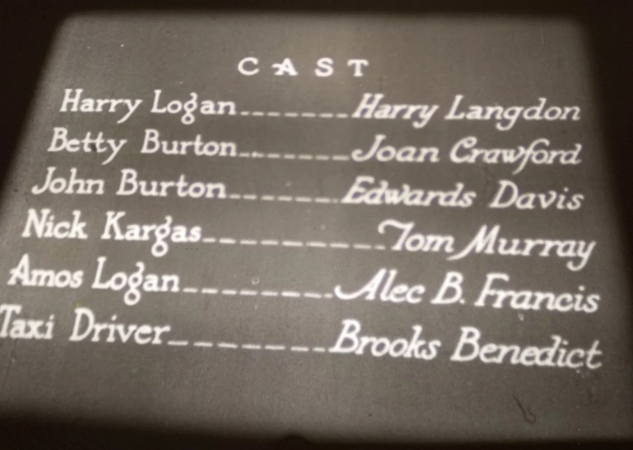
The Best of Everything
Encyclopedia Entry • Films Main
Tramp, Tramp, Tramp
1926

Critics' Reviews • Our Reviews • Movie Posters • Lobby Cards • Misc.
Click here to see photos from the film.
|
US release: 3/21/26.
DVD release (one of three films on the "Harry Langdon: The Forgotten Clown" Kino Video set): 9/2/03. DVD release (solo; Alpha Video): 11/19/24.
Preservation status: Fully restored by Martin Scorsese's Film Foundation. Prints exist in the film holdings of Cohen Media Group (Raymond Rohauer collection) and in the George Eastman Museum film archive. Cast: Harry Langdon, Joan Crawford (as "Betty Burton"), Edwards Davis, Carlton Griffith, Alec B. Francis, Brooks Benedict, Tom Murray. Credits: Story: Frank Capra, Tim Whelan, Hal Conklin, J. Frank Holliday, Gerald Duffy, Murray Roth. Producer: Harry Langdon Corporation. Director: Harry Edwards. Camera: Elgin Lessley, George Spear.
Plot Summary: When baby-faced comedian Harry Langdon left Mack Sennett Studios to make features for First National, he wisely brought along the two Sennett staffers who helped make him a star: gag writer Frank Capra and director Harry Edwards. Langdon's first feature-length comedy at his new studio was Tramp, Tramp, Tramp, which not only ranks as one of Harry's best efforts, but also one of the funniest comedies ever made. Our hero plays a bumbling cobbler's son who enters a cross-country walking race sponsored by shoe manufacturer John Burton (Edwards Davis). This he does partly to save his dad's business, but mainly out of love for Burton's daughter Betty (Joan Crawford), whom Harry knows only from her appearances on the Burton Shoe advertising billboards. As our hero tramp, tramp, tramps along, one mishap after another befalls him. At one point he is arrested and placed on a chain gang, leading to pantomimic tour de force in which the hapless Harry tries his best to make little rocks out of big ones. He also runs afoul of a belligerent herd of sheep, nearly plummeting off a cliff as a result. The climax finds Harry being literally swept off his feet by an outsized cyclone -- a surprisingly convincing special-effects sequence staged entirely within the studio! Miraculously, Harry wins the race and Betty's hand in marriage.... An amusing coda featuring a "baby" Langdon in his bassinette caps this well-nigh-perfect film. ~ Hal Erickson, All Movie Guide
Notes: • According to Frank Capra, leading lady Joan Crawford was so amused by Langdon's antics that she couldn't film her big scene with him without collapsing into laughter. As a result, the scene had to be shot with Crawford's back to the camera. (All Movie Guide) • On loan-out to First National from MGM for Tramp, Joan thought the makeup skills of First National were better: "When I got back to MGM I had picked up some makeup tricks that I clued in the MGM people on. I was made up better for the camera from then on, I feel." (Joan Crawford: The Essential Biography) • Musical numbers accompanying the silent film at NYC's Strand theater in 1926: Overture, excerpts from "The Firefly"; Vincent Lopez and his orchestra: "Odds and Ends," compilation of short subjects.
Little Bits of Classics (2016)
|
"Sisk" in Variety (1926)
Harry Langdon's first feature-length comedy. Langdon does some remarkable work....Aside from the expert handling of all the gags assigned him, he does several long scenes in which facial expression is the only acting. Joan Crawford is borrowed from Metro to be a nice leading lady with little to do.
Mordaunt Hall in the New York Times (May 24, 1926)
While viewing Harry Langdon to his first feature-length production, "Tramp, Tramp, Tramp," one is impelled to feel a greater respect for Charlie Chaplin's genius than ever, for although Mr. Langdon undoubtedly has a keen sense of the ridiculous there are in this new film several episodes that are strongly reminiscent of "The Gold Rush" and which suffer by comparison with the Chaplin comedy. You are able to enjoy Mr. Langdon's control over his features in portraying a very simple young man, but at the same time you can't help thinking how much more finished were the situations in Chaplin's picture. This, of course, is hardly Mr. Langdon's fault, but rather that of the half dozen authors who contributed to the gags in his story.
One of the passages mindful of Mr. Chaplin's effort is that in which Harry Logan (Mr. Langdon) climbs over a fence, only to discover that on the other side is a precipice. He is stopped from falling, from what appears to be a dizzy height, through his sweater catching on a single nail. Mr. Chaplin depicted much the same idea in the cabin sequence in "The Gold Rush" when he swung through the door while the frail frame structure was balanced on the edge of an Alaskan ravine. Then in this current picture there is a series of scenes in which Mr. Langdon battles against a high wind, as Chaplin did in the cabin, and also a glimpse of flying feathers from a pillow, similar to that in "The Gold Rush" where Chaplin was ecstatic over the promise of the girl to dine with him on New Year's Eve. In each instance the actual fun in the Langdon film is pictured more mechanically than that in "The Gold Rush." The scenes in this new photoplay are invariably abrupt in their termination.
Throughout the screening of "Tramp, Tramp, Tramp" there is a musical medley of "Tramp, Tramp, Tramp, the Boys are Marching" and "Tipperary," which fits in beautifully with the scheme of things in the tale, for our hero, Logan, during all his comic and exciting happenings, is walking from "Burton" Mass., to California, to advertise John Burton's shoes. Mr. Burton does not believe in hiding his light under a bushel, for one becomes familiar with Burton Park, the Burton billboards as well as the comfort and durability of Mr. Burton's shoes.
In connection with the stalwart efforts of Mr. Logan in the midst of an obstreperous cyclone, a caption reads: "David slew Goliath, Joshua stopped the sun, Daniel tamed the lions, but Harry Logan made a cyclone take the air."
There is a girl in the case. Her picture happens to adorn all the Burton billboards, and she is none other than Burton's daughter, Betty. She is very much interested in Logan, the man with the far-flung look, but not nearly as devoted to him as he is to her. Logan, before he meets her, kisses her picture in his uncomfortable room and he sleeps with a lithograph of her face on his pillow. These posters annoy one individual, who instils so much fear into Logan that the latter leaps into his bed and the electric fan, which had fallen on the pillow during a scuffle, suddenly starts churning up the feathers.
This is quite a jolly entertainment and it was obviously enjoyed by the majority of the Mark Strand audience yesterday afternoon. Vincent Lopez and his versatile musicians were heartily applauded by the audience.
TVGuide.com (excerpt from 2000s; exact year unknown) In Harry Langdon's first feature film, TRAMP, TRAMP, TRAMP, a young man takes Horace Greeley's advice and goes west--on foot. Popular with 1926 audiences, the movie established Langdon as a screen funnyman comparable in stature to Charlie Chaplin and Harold Lloyd... ...An amusing and sunny outdoor comedy, TRAMP, TRAMP, TRAMP seems weak only in comparison with Langdon's next feature, THE STRONG MAN (1926), a much richer blend of laughs, thrills, and tears. Among the earlier film's deficiencies is an anemic story. The bulk of the movie is devoted to little more than a succession of pickles Harry gets himself into on his way west. Nothing is made of the fact that the Logans' landlord and the world walking champion are the same man. (If one isn't paying close attention, one may not be sure that they are the same man.) And someone should have thought up a more humorous or exciting way for Harry to win the marathon; a viewer's reconstruction of the script would simply note that "Harry wins the race." TRAMP, TRAMP, TRAMP's romance is markedly inferior to that of THE STRONG MAN, in which the beloved of the sappy title character is not a sophisticated, unattainable beauty like Betty Burton but a simple small-town girl. Shrewdly, the latter was written as blind so that she cannot be disillusioned by the fact that her sweetheart looks like a 150-pound baby. Additionally, with seven credited writers and who knows how many uncredited ones (Langdon had a reputation for harboring numerous gagmen within his entourage), the picture should have included sharper, cleverer gags. Instead, too often TRAMP, TRAMP, TRAMP's camera is allowed to roll, roll, roll while its star exhausts his entire repertoire of puppyish movements and gestures. But watching even a somewhat misused Langdon is time well-spent, and TRAMP, TRAMP, TRAMP has its compensations, among them a cyclone that almost terminates Harry before he routs it with an effete flurry of rock throwing. (Two years later, Buster Keaton would get even more mileage out of a super-storm in STEAMBOAT BILL JR.) Some have found Langdon's reversion to literal infancy in TRAMP, TRAMP, TRAMP's closing minutes a little creepy, but the bit in which Harry is apprehended for poaching is, in fact, a lot more discomforting. Those with a weakness for psychosexual symbolism are guaranteed to raise an eyebrow or two at the scene's connotations of late-term pregnancy (the live chicken under Harry's shirt), scatology (the watermelon in the seat of his pants), and post-feeding-time satiety (his jam-smeared face). (Violence.) |
If you've seen Tramp, Tramp, Tramp and would like to share your review here, please e-mail me. Include a photo or avatar of yourself, as well as a star rating (with 5 stars the best) and any of your favorite titles from the film.
|
 Tom C. (November 2021) Tom C. (November 2021)Rating:
Tramp,
Tramp, Tramp (released March 1926) is a rare loan-out by MGM of Joan so
early in her career. Indeed, it's one of only 3 non-MGM films during
her time at the studio. The other two: Rain (1932, UA) and They All Kissed the Bride
(1942, Columbia). Tramp3 is a First National release that
stars Harry Langdon, one of
those comedians that people seem to either like or don't. He is from the
vaudeville school of slapstick comedy. I’ll be honest, his childish
mugging for the camera is not to my taste. Stephanie
has done a great job synopsizing the film in her review, so I’ll just
add that, in my opinion, a major fault in the film is that we're
expected to believe that beautiful, sophisticated, socialite Joan
somehow falls in love with this bumbling, backwoods simpleton. I'm all
for Hollywood magic, but that's too much of a stretch for me! Langdon
is a rube whose wheelchair-bound father is going to lose his shoe
store if they don't come up with cash quickly. Langdon enters a walking
race to win a $25,000 prize. The daughter of the shoe company sponsoring
the race is Betty Burton AKA Joan Crawford. Harry has a huge crush on
Joan---who can blame him!---because she's the poster child, literally,
for Burton Shoe Co., and is plastered on billboards from coast to coast.
Not surprisingly, Harry wins the race and the prize. Surprisingly, this
oaf also wins the heart of lovely Betty by movie's end. The
movie is all Langdon. Apart from him, no one gets much to do, JC
included. Alex Francis, who was in the early Joan film The Circle
(1925), plays Harry's dad. Tom Murray, who plays the pompous world
champion walker Nick Kargas, is best known for playing a villain in
Chaplin's Gold Rush (1925). Per
IMDB, this was the first film that Langdon produced on his own.
Previously, Langdon worked for Mack Sennett. Langdon seems like he’d be
more funny in limited doses, and more suited to a Sennett two-reeler.
The movie also has future director Frank Capra as a writer. Like
many of her earliest films, Joan has limited screen time. The one good
scene is the one that has the most Joanie time. It's an interchange
between Harry and Joan about 12 minutes in: he realizes the girl of his
dreams is standing next to him. Per Frank Capra's autobiography, in this
scene they mostly shot Joan from behind because she was cracking up at
Langdon's antics. Girl’s got a weird sense of humor! Joan---who was so critical of her work---later
told interviewer Lawrence J. Quirk (Joan Crawford: The
Essential Biography): "Tramp,
Tramp, Tramp was a wistful comedy but the picture belonged to Harry
Langdon. I was playing not second fiddle, not third fiddle, but more
like fifth fiddle to Harry’s comic stunts." One interesting tidbit I gleaned from
the littlebitsofclassics Word Press site was that Joan thought she
was filmed to better effect here than in her MGM films. Maybe this
“look” and her performance is what convinced MGM that JC might be a
marketable star, and thus groomed for bigger roles with their top
leading men like Chaney, Novarro, and Gilbert. 1926
was a pivotal year in the great diva's career, I would argue THE
pivotal year. You get the feeling that lending her out to First National
suggested that MGM did not yet know what they had in Joan or what to do with
her. They must have thought enough of her rookie season since they
picked up her option. But, after 11 appearances in 1925, mostly in bit
parts, she had only 4 in 1926. One of these---The Boob---was shot in
1925 and not released until May 1926. In Bardelys the Magnificent (Sept.
1926), Joan has a fleeting part as a court gossip. Her other
film of 1926 is Paris, released in May, which is effectively lost, save
for a 13-second clip on YouTube, but from available reviews, promotional
materials, etc., seems to have been a very significant role for Joan.
In 1927, she's the female lead in Winners of the Wilderness. Then, Taxi Dancer,
her first top billing. From
there, more or less, only star and leading-lady roles for most of her MGM
career. From what I’ve read, Tramp3 was a minor hit upon its release, and The Boob, which had been shelved, was released to capitalize on Joan’s growing popularity. So, perhaps, in the grand scheme of things, Tramp3 is, to paraphrase Churchill, not the beginning of the end, but rather the end of the beginning of the great story known as Joan Crawford’s movie career. Overall,
a movie for Joan completists and Langdon aficionados. I'm the former.
1/2 star for the film, 1/2 star for helping give us the JC "look" we
love, and 1/2 star because I think this is the turning point in her
career! 1.5 stars in total.
Rating:
In Joan's fifth credited film, a Silent, she's on loan-out from MGM to First National to play the love interest ("Betty Burton") to silent comic Harry Langdon, who here appears in his first feature-length film after having worked in Mack Sennett shorts since 1923.
Langdon plays "Harry Logan," the son of a local shoemaker who now can't make ends meet because the giant corporation Burton Shoes has been wiping out competition with their successful billboard ad campaign featuring Burton's daughter Betty. (We get our first glimpses of Joan as a face advertising Burton's product, both on display in the Burton Shoes office and on the billboard directly across from Harry's Pa's shoe shop that Harry can't quit ogling.)
Pa will lose his shop altogether if he can't come up with rent. Potential rescue comes in the odd form of Burton Shoes having a cross-country walkathon publicizing the product that pays $25,000 to the winner. On the day the race begins, Harry stands around pondering how to save his pa's shop (while simultaneously ogling the Betty billboard); the real Betty appears and convinces him to join the race. After diddling and dawdling and professing his love, he's off on his big mission!
Now, this set-up seems at this point to be extremely full of promise: You've got the political ("Big Corporation vs. The Little Guy") as well as the "Romeo and Juliet" angle ("daughter of capitalist yearns for son of small shop owner"). Not to mention the fact that the wicked landlord who wants to close Pa's shop for non-payment of rent is also, improbably, the prime competitor in the walkathon! Unfortunately, all of this interesting psychological backstory is immediately tossed out once the race begins, not to be referred to again.
It is a Langdon feature, after all, so of course the focus should be on Langdon and his shenanigans...It's just that Langdon's not that interesting to watch, nor is the gag-writing for the film particularly clever. (NOTE: Famed director Frank Capra is one of six writers of the film.) Langdon's schtick is that he's a mild-mannered, childlike character who reacts to goings-on in a baby-faced, lackadaisical way... I can't help but compare him to Chaplin and Keaton, also rather childlike, disheveled, ragamuffin characters. The difference between these two and Langdon, though, is that the formers' interplay with and interpretations of their comedic situations seems a lot more engaged and witty and fast-paced---they had an adult sensibility despite their man-child personae. I have no idea who wrote the material for Chaplin and Keaton's early films; maybe Langdon's writers were just not up to snuff, but if that's the case, then he's still the one responsible for making the most out of sub-par material. He doesn't do so in this film. (A side-note, his looks were also kind of distracting to me: His pale baby-face, tiny kohl-rimmed eyes, and red lips made him, to my modern sensibility, the creepy spitting image of talk-show host Sally Jesse Raphael.)
There are the requisite "money" scenes, and Langdon is not uneffective in them, it's just that they run on too long and try to milk too little funny material. First is the hotel scene with Harry and the rival landlord. Harry has pinned up numerous pictures of Betty. The landlord meanly tears them down and demands some sleep before the big race. When Harry tries to "quietly" hammer up another Betty picture, there's the predictable mayhem as Harry loudly falls about and destroys the room. There is one mildly clever bit where a fan falls into Harry's bed and proceeds to stir up the joint, but overall the scene is slow, especially after the landlord gives Harry booze and pills to make him sleep. The viewer expects some major comedic pay-off here, but Langdon just kind of looks into the camera with a "boozy" expression for a few moments...and then goes to sleep. And is late for the Big Race the next day, with little consequence. OK...
The next big scene is during the race, when Harry is caught amid a flock of sheep and is forced to climb a fence for protection. On the other side of the fence, he finds himself dangling over a steep cliff and pulls out nails from the fence to hammer his clothes onto it so he won't fall; the fence gives and he slides down the now-sloping hillside to ultimate safety. The slide down the hill was one of the more fast-paced moments of the film, but... I can't help but think of what Chaplin might have initially done among the huge flock of sheep! The dangling-over-the-cliff thing is a trope of silent films; it's what an actor does in other, less stereotypical, moments that makes him memorable... Langdon goes on to be part of a chain-gang after stealing some fruit while walking: His picking out a tiny hammer to pound on tiny rocks is cute; but then when a big lug accidentally hits him over the head with a sledgehammer, Harry's response is to look befuddled for the first two times, and then to throw a big rock and bonk the guy over the head. Ha-ha.
In the final scene, a cyclone blows into town. Surprise---Harry's umbrella turns inside out! He does get to, more funnily, wear a shower curtain after his clothes have blown away, and rescue Betty (also funnily fanning her in the middle of the windstorm and later throwing a rock after the departing storm in David-and-Goliath fashion; his mid-storm goings-on are also credited with inspiring Buster Keaton's later, better-done scenes in "Steamboat Bill, Jr.").
Post-storm, he wins the race and is united with Betty. As they look into their home, there's Langdon himself as their bonneted baby in an oversized bassinet---gurgling, sneezing, rocking, chewing on balls and stuffed animals...I'll grant that this is funnily weird! But overall, Langdon's sense of comedy seems extremely slow-pokey and uninspired.
Oh, and about Joan...She looks very attractive and smartly turned out in her few appearances. How she's often presented onscreen is interesting to me: This has to be one of the first cinematic cases of a female with a very small part being overtly fetishized. We often see her as others in the film see her: First viewed on a billboard, later seen onscreen by Harry's Pa as he watches newsreels featuring the race at his local theater. It reminded me of a tactic that later filmmakers employed (more skillfully and with greater psychological intent): The Sharon Stone character in Woody Allen's "Stardust Memories" and Jessica Lange in "All That Jazz"---a dream-girl muse, briefly seen but nonetheless propelling the picture...
|



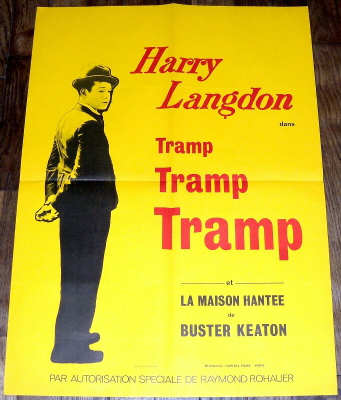
Above: Unknown, two US posters, and a French re-issue from 1970s.
Thanks, Jon M., for sending along the 4 cards in the center.




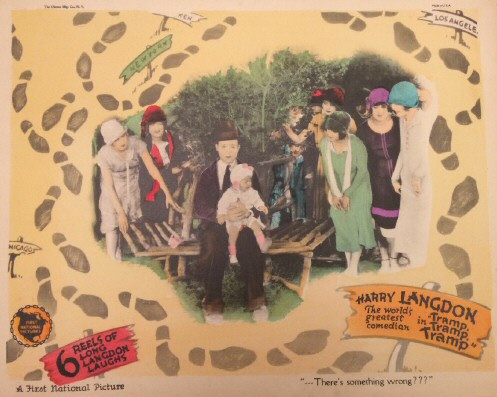

Below: A series of 1926 US Film Daily ads promoting the cross-country trek of Langdon's character


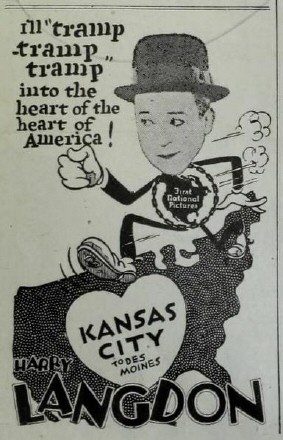
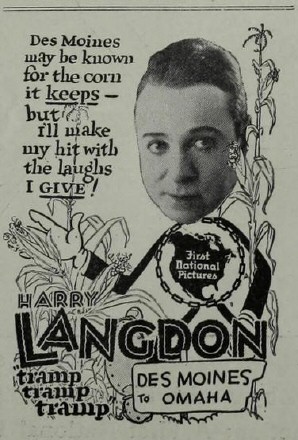
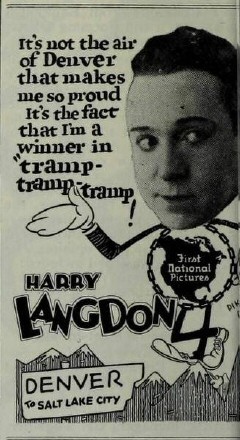
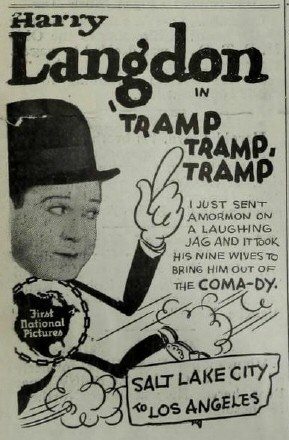
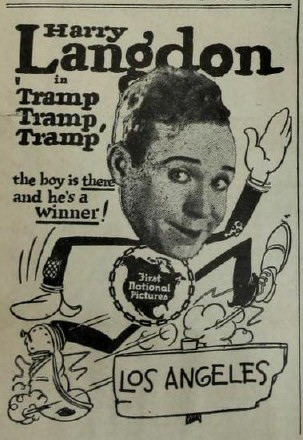
Below: US Film Fun magazine ad, US newspaper ad, and page 10 of 12-page Exhibitors Daily Review ad-campaign supplement (click picture to view all 12 pages).
Below: US herald front/back covers and centerfold.


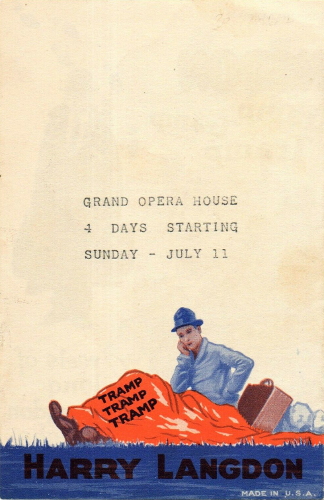
The Best of Everything